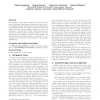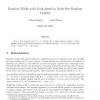344 search results - page 2 / 69 » Random Walks on Colored Graphs |
WWW
2009
ACM
14 years 6 months ago
2009
ACM
We introduce a multi-label classification model and algorithm for labeling heterogeneous networks, where nodes belong to different types and different types have different sets of...
RSA
2006
13 years 5 months ago
2006
We analyze Markov chains for generating a random k-coloring of a random graph Gn,d/n. When the average degree d is constant, a random graph has maximum degree (log n/ log log n), ...
SIAMDM
2010
13 years 10 days ago
2010
If m 2 is constant and 0 r log log n for a small positive constant , then whp a random walk with look-ahead r on a scale-free graph G = G(m, n) has cover time CG(r) (2/(mr-1(...
COMBINATORICA
2008
13 years 5 months ago
2008
A parity walk in an edge-coloring of a graph is a walk along which each color is used an even number of times. Let p(G) be the least number of colors in an edge-coloring of G havi...
STOC
2002
ACM
14 years 5 months ago
2002
ACM
Two infinite walks on the same finite graph are called compatible if it is possible to introduce delays into them in such a way that they never collide. Years ago, Peter Winkler a...


